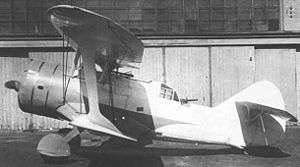Kochyerigin DI-6
Kochyerigin DI-6 (internal designation TsKB-11; Russian: Кочеригин ДИ-6/ЦКБ-11) was a two-seat fighter biplane produced in the Soviet Union in the 1930s.
| DI-6/TsKB-11 | |
|---|---|
 | |
| Kochyerigin DI-6i | |
| Role | Fighter |
| National origin | Soviet Union |
| Manufacturer | Factory No.39 |
| Designer | Sergei Aleksandrovich Kochyerigin |
| First flight | 30 September 1934 |
| Primary user | Soviet Air Force |
| Number built | 222 |
Design and development
The DI-6 was a conventional single-bay biplane of mixed construction with cable-retracted main landing gear. The pilot and the tail gunner sat in tandem cockpits, the pilot's open, and the gunner's partially enclosed. To maximize the gunner's arc of fire, the rear cockpit was set lower in the fuselage than the pilot's.
The DI-6 was developed at TsKB as a fighter that would also be capable of ground attack when fitted with different armament. Originally intended to use a liquid-cooled V-12 engine, problems with its development led to the choice of the Wright R-1820 radial engine instead. The first flight took place on 30 September 1934, and testing began in earnest in early 1935, with State Acceptance Trials following between May and November. Despite a number of weaknesses discovered during testing, the type was ordered into production, and deliveries to the Soviet Air Force commenced in the spring of 1937. Problems including excessive vibration, and a poor field of fire for the gunner, were never adequately resolved, and the various fixes implemented to cure these and other problems eventually added around 160 kg (350 lb) to the aircraft's weight. Production continued until 1939.
Operational history
Pre-Glastnost Western sources often reported these aircraft as having participated in the Battle of Khalkhin Gol against Japan in 1939, and even in the Winter War against Finland in 1939–1940, but more recent scholarship has failed to uncover any evidence that it was deployed in either case.[1]
Surviving examples
A replica DI-6 is displayed in Victory Park, at the Museum of the Great Patriotic War in Moscow.
Variants
- DI-6bis
- Trainer with fixed landing gear.
- DI-6Sh (TsKB-11Sh, TsKB-38)
- Ground attack variant with armored pilot's seat and four forward-firing PV-1 machine guns under the bottom wing; 60 built.
- DI-6MMSh
- One prototype with M-300 X engine, did not enter production.
Specifications (DI-6)
Data from Shavrov 1985[2]
General characteristics
- Crew: 2
- Length: 6.87 m (22 ft 6 in)
- Wingspan: 9.94 m (32 ft 7 in)
- Height: 3.2 m (10 ft 6 in)
- Wing area: 25.15 m2 (270.7 sq ft)
- Empty weight: 1,360 kg (2,998 lb)
- Gross weight: 1,955 kg (4,310 lb)
- Powerplant: 1 × Shvetsov M-25 9-cylinder air-cooled radial piston engine, 522 kW (700 hp)
- Propellers: 2-bladed variable-pitch propeller
Performance
- Maximum speed: 372 km/h (231 mph, 201 kn)
- Range: 500 km (310 mi, 270 nmi)
- Service ceiling: 7,700 m (25,300 ft)
- Time to altitude: 5,000 m (16,404 ft) in 10 minutes
- Wing loading: 78 kg/m2 (16 lb/sq ft)
- Power/mass: 0.267 kW/kg (0.162 hp/lb)
- Horizontal turn time: 12 seconds
Armament
- Guns: 3× 7.62 mm (0.3 in) ShKAS machine guns, two unsynchronized firing forward and one on a rear-facing mount, 750 rounds/gun
- Bombs: Up to 40 kg (88 lb) of bombs
References
| Wikimedia Commons has media related to Kochyerigin DI-6. |
- Mellinger
- Shavrov V.B. (1985). Istoriia konstruktskii samoletov v SSSR do 1938 g. (3 izd.) (in Russian). Mashinostroenie. ISBN 5-217-03112-3.
- Taylor, Michael J. H. (1989). Jane's Encyclopedia of Aviation. London: Studio Editions. p. 561.
- Russian Aviation Museum
- Уголок неба
- Mellinger, George. "Soviet Air Order of Battle for the Khalkin Gol Incident". j-aircraft.com. Retrieved 2008-09-11.